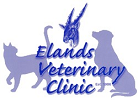Endoscopy
-
Veterinary Surgeons referring a patient to Elands Veterinary Clinic
- Please complete ALL parts of the form
- We will arrange a suitable appointment direct with your client
- We will email you confirmation of the appointment
- Please ensure that we receive the referral form and FULL history with ALL relevant laboratory reports/radiographs etc.
It is the practice policy not to process direct claims except in exceptional circumstances. Any direct claims must be authorized prior to surgery and clients must present the practice with a signed and completed form BEFORE the procedure. There is a fee for this service payable at time of admission.
Laparoscopic Neutering
-
In Females
Vets at Elands Veterinary Clinic pioneered Laparoscopic spays in the UK. The most common form of laparoscopic neutering performed in female animals is an ovariectomy. This is where only the ovaries are surgically removed, and the uterus is left behind. Research over the past forty years has shown no advantages to removing the uterus and no risk of pyometra in the absence of the ovaries. This procedure renders the animal sterile, and females that have been neutered by this method are at less risk of post-operative complications (such as haemorrhage) than those that have had a full ovariohysterectomy by conventional open surgery (the removal of the ovaries and uterus). Keyhole spays also allow a close inspection of the whole abdomen, which is not possible in an open spay (where almost none of the abdominal contents can be seen), and tissue handling is much more delicate and less traumatic. It is a much kinder procedure for our patients.A full ovariohysterectomy is only performed if visual inspection of the uterus reveals any areas of concern for the veterinary surgeon.
In both cases, the patient is left with wounds that are significantly smaller (and therefore less painful or traumatic) than the wound needed to perform an ‘open’ neutering. There are two small wounds in a keyhole spay of 3 to 5mm instead of the normal open spay wound of 60 to 70mm. This means that the post-operative recovery time is shorter compared to that of the ‘open’ method, less in the way of post-operative pain medication is needed, and that there is a much shorter period of restriction of exercise.
In Males
Although a routine castration is a relatively minor surgical procedure, in cases where one (or both) of the testicles are retained in the abdomen – called cryptorchidism – laparoscopy offers the gold-standard level of surgical treatment. Abdominal testicles are at a higher risk of becoming cancerous.Using a laparoscopic approach, surgeons need only make tiny incisions to introduce special instruments and cameras into the abdominal cavity. Due to the high picture quality and level of magnification provided by the equipment, retained testicles are easy to locate, and can then be removed in a minimally traumatic fashion. A patient that has undergone a laparoscopic/laparoscopic-assisted correction for cryptorchidism may well only have an incision that is a 10m to 15mm long, versus the incision needs for an exploratory laparotomy, which may be around 100mm long.
There is no size limit on patients for keyhole spays and we routinely spay cats and bitches as small as 1.5kg as well as giant breeds as large as 75kg.
You do not need to be referred by your own veterinarian to visit us for the laparoscopic spay, just complete our self-referral form and one of our team will contact you to book in.
Flexible Endoscopy
- Bronchoscopy – for examination of the trachea and interior of the lungs with targeted sampling, such as lavage and removal of foreign bodies
- Gastro-duodenoscopy – examination of the oesophagus, stomach and upper part of the small intestine with biopsies. We are able to remove oesophageal and gastric foreign bodies
- Lower Gastro-intestinaI endoscopy – examination of the rectum, colon, caecum, ileum to take biopsies.
Rigid Endoscopy
Rigid endoscopy is a minimally invasive surgical technique that uses specially adapted instruments and cameras to access areas of the body that are otherwise inaccessible without major surgical intervention.
The use of digital recording equipment and high-definition monitors allows much improved visualisation of the area of interest, and allows targeted sampling of potential lesions. Surgical procedures utilising rigid endoscopy are often referred to as ‘keyhole’ procedures.
Some examples of procedures using rigid endoscopy are:
- Laparoscopy - detailed examination and targeted sample of the abdominal organs complete with photography and recording facilities for record keeping e.g. liver, pancreatic, full thickness intestinal and renal biopsy. Also lap assisted cystoscopy, lap assisted splenectomy and exploratory laparoscopy.
- Rhinoscopy - Examination internal structures of the nasal cavity and sinuses with the option for biopsies and removal of foreign bodies
- Urethrocystoscopy - Examination and biopsy of the vestibule, urethra, vagina and bladder.
- Video otoscopy - Treatment otitis externa and media. Biopsy/removal of aural polyp.
Rigid endoscopy can also be used to provide a minimally invasive component to otherwise major surgery, for example: laparoscopic-assisted cystotomy, enterotomy or splenectomy.
All of these procedures can be carried out on cats as well as dogs.
